Cooperative Research Programs Series
Periodicals and Other Documents
|

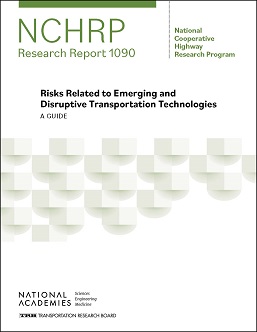 Risks Related to Emerging and Disruptive Transportation Technologies: A Guide
6/3/2024 2:00:00 PM
Risks Related to Emerging and Disruptive Transportation Technologies: A Guide
6/3/2024 2:00:00 PM
Emerging technologies present many potential challenges to state departments of transportation (DOTs) and other agencies that own and manage the existing infrastructure. Significant uncertainty exists about which changes are most likely to occur and where the largest impacts could be, hampering an effective national alignment in policy and approach. NCHRP Research Report 1090: Risks Related to Emerging and Disruptive Transportation Technologies: A Guide , from TRB's National Cooperative Highway Research ...
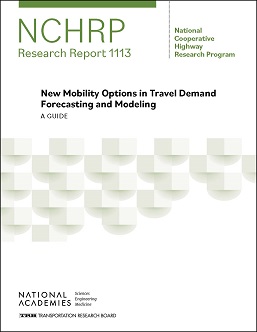 New Mobility Options in Travel Demand Forecasting and Modeling: A Guide
5/24/2024 6:00:01 PM
New Mobility Options in Travel Demand Forecasting and Modeling: A Guide
5/24/2024 6:00:01 PM
Emerging transportation technologies and shared mobility services, or new mobility options (NMOs), are affecting travel behavior and demand. NMOs may include shared micromobility, transportation networking companies (TNCs), and connected and autonomous vehicles (CAVs). As NMOs grow in availability and use, transportation planners and decision-makers need to be able to understand how to harness positive and mitigate negative impacts. NCHRP Research Report 1113: New Mobility Options in Travel Demand Foreca...
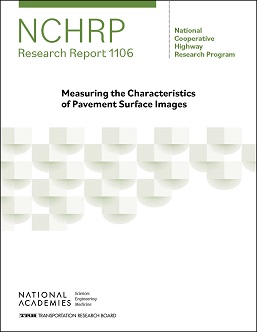 Measuring the Characteristics of Pavement Surface Images
5/17/2024 2:00:41 PM
Measuring the Characteristics of Pavement Surface Images
5/17/2024 2:00:41 PM
Imaging systems are commonly used for conducting pavement evaluations. The American Association of State Highway and Transportation Officials' Standard Practice for Collecting Images of Pavement Surfaces for Distress Detection addresses the collection of images. However, there are no widely accepted methods for measuring the characteristics of pavement surface images such as 2-dimensional optical images and 3-dimensional surface elevation images. NCHRP Research Report 1106: Measuring the Characteristics ...
 Business Intelligence Techniques for Transportation Agency Decision-Making
5/17/2024 2:00:16 PM
Business Intelligence Techniques for Transportation Agency Decision-Making
5/17/2024 2:00:16 PM
Strategic approaches to the management and operation of transportation systems blend knowledge of agency goals, asset conditions, traffic and safety performance, and finance and budget constraints. This knowledge is based on data, and many agencies are implementing consolidated data governance practices to improve data quality, maximize the value of the data to the agency, and better manage data collection and analysis resources. NCHRP Research Report 1099: Business Intelligence Techniques for Transporta...
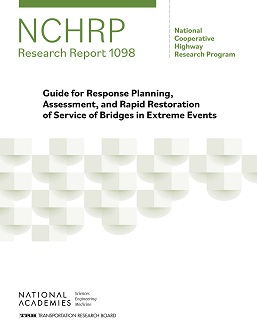 Guide for Response Planning, Assessment, and Rapid Restoration of Service of Bridges in Extreme Events
5/16/2024 3:00:28 PM
Guide for Response Planning, Assessment, and Rapid Restoration of Service of Bridges in Extreme Events
5/16/2024 3:00:28 PM
Extreme events resulting from natural or other disasters, such as fires, floods, earthquakes, tornados, and hurricanes, can damage bridge structures in ways that impact the safety of motorists and the public. The procedures currently employed for response planning, assessment, and rapid restoration of service of these structures to maintain safety do not always address the full range of needs for personnel, communication, coordination, data collection, assessment levels, and other factors associated with...
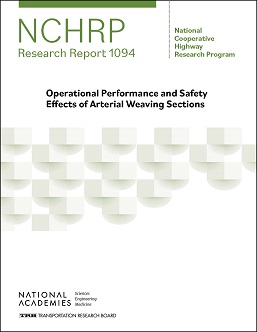 Operational Performance and Safety Effects of Arterial Weaving Sections
5/16/2024 3:00:05 PM
Operational Performance and Safety Effects of Arterial Weaving Sections
5/16/2024 3:00:05 PM
As drivers place increasing demands on transportation infrastructure and freeway congestion continues to increase, arterials have become an alternative route for many drivers, resulting in the lower performance of these roadways. In many areas, weaving maneuvers – defined as the crossing of two or more traffic streams in the same direction between two or more access points on a multilane urban street with some type of traffic control – negatively affect arterial operations and safety. NCHRP Research Repo...
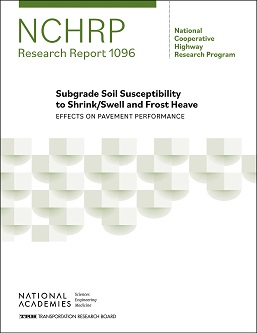 Subgrade Soil Susceptibility to Shrink/Swell and Frost Heave: Effects on Pavement Performance
4/12/2024 5:15:00 PM
Subgrade Soil Susceptibility to Shrink/Swell and Frost Heave: Effects on Pavement Performance
4/12/2024 5:15:00 PM
Expansive clay soils that are susceptible to shrink and swell and silty soils that are susceptible to frost heave are found in many parts of the United States. At these locations, these soils serve as the subgrade of the pavement structure. NCHRP Research Report 1096: Subgrade Soil Susceptibility to Shrink/Swell and Frost Heave: Effects on Pavement Performance , from TRB's National Cooperative Highway Research Program, presents a state-of-the-art update to pavement design procedures to better reflect the...
 MASH TL-3 Deflection Reduction for 31-Inch Guardrail: A Guide
4/9/2024 2:12:23 PM
MASH TL-3 Deflection Reduction for 31-Inch Guardrail: A Guide
4/9/2024 2:12:23 PM
Roadside obstacles are often too close to the roadway to permit the installation of common guardrail designs. Guardrail systems are often modified with a combination of tighter post spacing, nesting of rails, and other guardrail stiffening mechanisms to reduce deflections. NCHRP Research Report 1100: MASH TL-3 Deflection Reduction for 31-Inch Guardrail: A Guide , from TRB's National Cooperative Highway Research Program, presents a guide on the use of stiffening mechanisms to reduce the deflection for 31-...
 Transformational Technologies and Mobility Inclusion Playbook
4/4/2024 7:00:14 PM
Transformational Technologies and Mobility Inclusion Playbook
4/4/2024 7:00:14 PM
Changes in technology provide opportunities and risks to mobility, particularly as they relate to traditionally and newly underserved populations. In recent years, economic, environmental, and social forces have quickly given rise to shared and on-demand mobility—a collective of entrepreneurs and consumers leveraging technology to maximize transportation and financial resources and generate capital. For instance, shared mobility services have become part of a trend that has pushed shared, on-demand mobil...
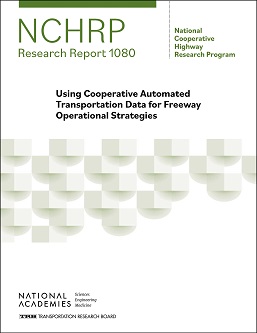 Using Cooperative Automated Transportation Data for Freeway Operational Strategies
4/4/2024 6:00:04 PM
Using Cooperative Automated Transportation Data for Freeway Operational Strategies
4/4/2024 6:00:04 PM
Since the introduction of digital computers more than 50 years ago, continuous developments in computer technology, emerging data sources, and communications have created opportunities for operational strategies and performance measures to improve freeway network safety and mobility. NCHRP Research Report 1080: Using Cooperative Automated Transportation Data for Freeway Operational Strategies , from TRB's National Cooperative Highway Research Program, is an assessment of transportation operational scenar...
|
|